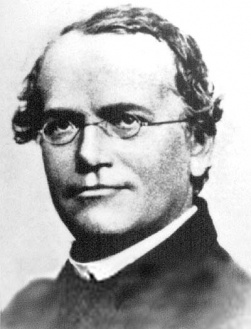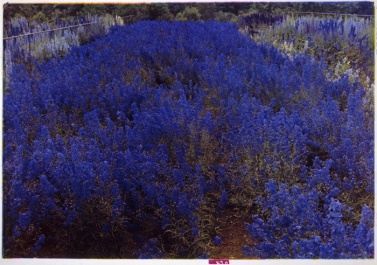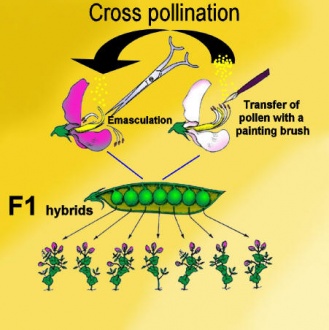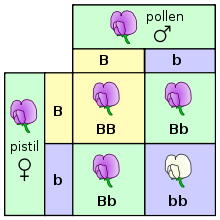Mendel's Laws of Inheritance
Mendel’s Laws of Inheritance
Prior Work:This can serve as in introductory lesson on genetics. I teach this, however, to sixth graders who have had background in how eye color is passed down from one generation to the next. These students know the terms, "dominant," and "recessive," "genotype," and "phenotype."
Materials Needed: Cultural notebooks and a pencil.
Age: 10-12
Presentation:
1) Have student record the following vocabulary. Short definitions
Inheritance, Generation, Domestication, Monk, Pollination, Stamen, Pistil, Offspring, Carpel
Inheritance—passing down traits from generation to generation. Generation—The change in time from a parent’s life to its offspring. Domestication—taming of plants or animals for human use. Monk—a member of a religious order devoted to prayer. Pollination—Transfer of male pollen to the female pistil. Stamen—the male part of a plant that carries the pollen. Pistil—the female part of the plant that receives the pollen. Offspring—in plants, the offspring are the seeds. Carpel—the part of the plant in which the seed is formed Mendel:
2) What is domestication of animals? What culture first domesticated animals? (Sumerians) How Long ago? (5,000 years). (Name some advantageous characteristics: sheep with more wool, cow with more milk, more aggressive dog, etc.) People knew how to breed desired characteristics into animals by mating pairs with the desired traits. How are these two horses different from each other? What do you think each horse would be used for? How did humans develop each type of horse?
People also learned how to breed crop plants with bigger seeds, or different types of flowers, but no one knew how this mystery worked until Gregor Mendel. File:Mendel pu.jpg 2.)Mendel was a monk, who was born in 1822. The religious life often gave people the time they need to do this kind of work. My own Aunt Ruth (Sister Hilaire) was a botany professor. She had an entire greenhouse at her disposal for student work, experiments, etc.
3) Before Mendel, people thought that features of each parent blended together, like paint on a palette. They noticed that kids looked like their parents, but they thought it was a blending of features. No one understood why certain features in one parent disappeared for a generation, and then reappeared later. If you look at the photo below, what traits seem to be blended in the flowers that appear on the outside of the frame?
4) Mendel chose pea plants for his experiments because they had clear-cut features.
—They were either TALL or SHORT. (Never medium-sized) —The flowers were either PURPLE or WHITE. —He also tested other traits: if the seed color is yellow or green, if the flower position is axil or terminal, if the pod shape is inflated or constricted, if the pod color is yellow or green, and if the seed shape is round or wrinkled. —Pea plants also reproduce rapidly and have many new generations in a short amount of time.
Mendel wanted to see how these characteristics were passed down from one generation of pea plants to the next.
5)Do you know how pea plants reproduce? Male and female sex organs are found together inside the pea plant flower. Tiny male pollen grains on the stamen are carried to the female organs, the pistil, which includes the carpel, in a process called pollination. A seed is formed, which can then grow into a new plant.
6) Mendel’s experiment.
—Crossing. With a paintbrush he carefully transferred pollen from the stamen of a purple flower to the pistil of a white flower. When the plant produced seeds, he planted them and observed the color of the flower. Have the students observe the diagram below and tell what they see happening.
—Next, he allowed the offspring to produce seeds, planted them, and observed the results.
7) The results:
—With a white male and a purple female parent, all the flowers of the first generation were purple. —
—But the white flower appeared in the second generation at a ratio of ¼. One out of every four offspring was white.
8) Mendel suggested that inside each plant were “factors of inheritance,” that we now call genes. He thought that the white plant gave a white factor to the seed, while the purple plant gave a purple factor to the seed. Therefore the plants each carried one white and one purple factor. Why did they all turn purple?
—They turned purple, Mendel said, because purple is “dominant” over white. That means that if they are each present, the purple will win out.
—By the second generation, each seed will contain a white factor and a purple factor. One plant will have two purple factors. Two will have one of each, and one will have all white. How many plants will have purple flowers in the second generation? Right, three. Only the plant with two white factors will turn out white because purple is always dominant over white. Because the white factor won’t show itself unless it is paired with a second white factor, Mendel called this factor recessive.
9) What are your impressions of Mendel as a man and as a scientist? What character traits allowed Mendel to succeed?
10) Today, we talk about dominant and recessive genes. Can you think of pairs of characteristics that humans have?
—Eye color: brown, green, blue, hazel. Which are dominant and which are recessive? —Hair color: brown, blond. Which is dominant, and which is recessive? —What about height? If you have one tall parent, and one short parent?
Direct Aim: To Learn that Gregor Mendel is the father of genetics. To reinforce knowledge and understanding of dominant and recessive traits first learned in the study of eye color (“Genetics 1)
Indirect Aim: To show students that science is a matter of carefulness, patience, and precision. Great work is done almost as a meditation, the way a monk would. Too often we think of success as a form of aggression. The powerful leader of a country or an army. Even the vocal leader of a movement. Getting ahead means getting others out of the way, or at least forcing them to do what you want them to do. But Mendel shows us that success is more likely a matter of deep concentration.
Suggestions for Student Work:
Ask students what ideas they have for followup work? Biographical? A punnet square? A chart of Mendel's pea experiments. You can also reinforce understanding of genotype (make contain a recessive gene that doesn't show) and phenotype (what shows). Can you think of someone who demonstrates this other idea of success? The success born of deep concentration, not the success born of aggression? Write a report about such an individual, and compare this person to what you already know about Mendel.






